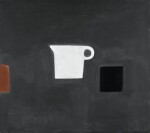Irish Art, including Property from the Collection of Sir Michael Smurfit
Irish Art, including Property from the Collection of Sir Michael Smurfit

WILLIAM SCOTT, R.A. | POEM FOR A JUG, NO. 23
Auction Closed
September 9, 02:37 PM GMT
Estimate
70,000 - 100,000 GBP
Lot Details
Description
WILLIAM SCOTT, R.A.
1913-1989
POEM FOR A JUG, NO. 23
signed on reverse
oil on canvas
81.5 by 91.5cm., 32 by 36in.
Executed in 1980.
Gimpel Fils, London
Gimpel & Weitzenhoffer, New York
Julian Lax, London
Beaux Arts, London, where purchased by the present owner in 2002
Norbert Lynton, William Scott, Thames & Hudson, London, 2004, pp. 336, 338;
Sarah Whitfield (ed.), William Scott: Catalogue Raisonné of Oil Paintings, Volume 4 1969-1989, Thames and Hudson in association with William Scott Foundation, London, 2013, cat. no.891, illustrated p.274.
London, Gimpel Fils, Poem for a Jug, 20th May – 21st June 1980, cat. no.23 (dated 1979-80);
London, Gimpel & Weitzenhoffer, William Scott, 26th April – 28th May 1983.
Conceived as part of a series of 26 and executed throughout 1979 until the early months of 1980, Poem for a Jug, No.23 incorporates William Scott’s familiar still-life components, dominated by a simplified jug motif. It belongs to the final eight works from the series executed on the larger scale. The series was shown in its entirety at the Gimpel Fils gallery in 1980 and appears to have been developed from a group of four small 'jug' paintings shown in Toronto the previous year.
William Scott elaborates on the title he adopted for the series of works within a letter to Jean-Yves Mock dated 26 April 1980: 'My immediate problem for the catalogue when we discussed it last week was how to title so many works with the same subject. While at Coleford I arrived at the conclusion that one title could cover them all and inspired by Keats I decided to call it 'Poem for a Jug' using "Poem" rather than "Ode" and "Jug" rather than "Urn".' (Sarah Whitfield (ed.), William Scott: Catalogue Raisonne of Oil Paintings, 1969-1989, Vol. 4, 2013, p.258). Scott refers to John Keats’s 1819 poem Ode on a Grecian Urn, the final lines of which read: 'Beauty is truth, truth beauty, -that is all/ Ye know on earth, and all ye need to know.'
Scott’s oeuvre reveals an extraordinary engagement with the still-life subject, offering limitless possibilities to this traditional motif. In the present series, Scott reduces the subject to its bare minimum, with subtle variations to colour, form and placement. Here, the jug sits poised in the middle of the work, delicately balanced by the half-ambiguous forms either side. As Norbert Lynton suggests ‘with so few items to look at, almost all communication is carried by placing and visual weight’ (Norbert Lynton, William Scott, Thames & Hudson, London, 2004, p.337-8).
At first glance, one anticipates the surface to be smooth and crisp; however, closer engagement reveals a painterly surface and subtle variations in tone. There is also a soft diffusion to the form of the objects, the glow to their edges lifting them from the surface. This is one of the few examples in which Scott uses a dark background, thereby heightening the presence of the white jug. The overall effect is a simple yet arresting image. Indeed, the painting beautifully expresses what Scott declared at the beginning of his career in 1947, and which lies at the heart of his work: ‘I find beauty in plainness, in a conception which is precise…a simple idea which to the observer in its intensity must inevitably shock and leave a concrete image in the mind.’
